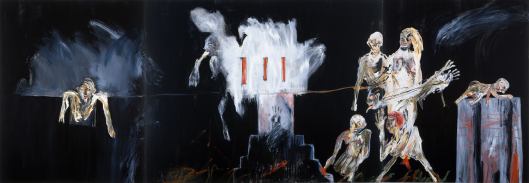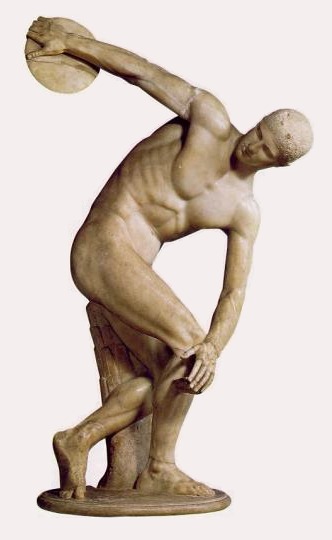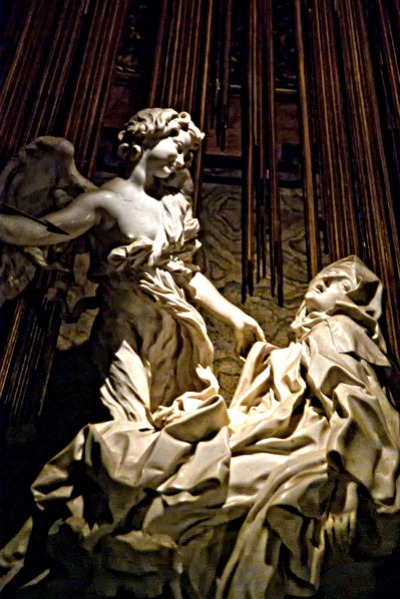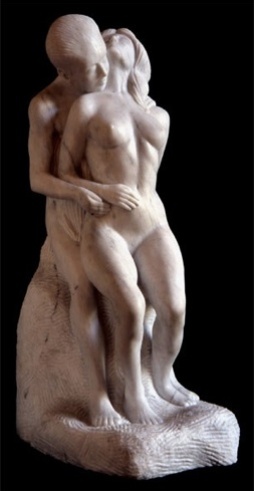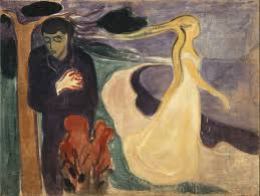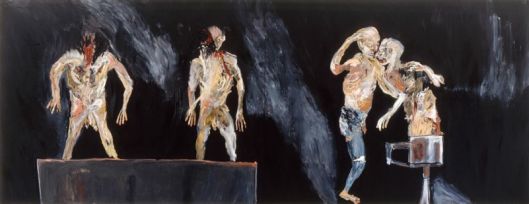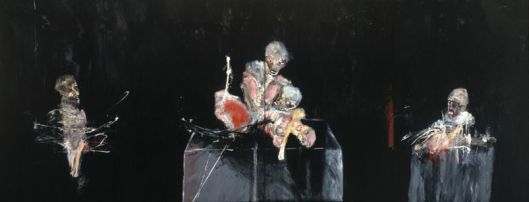The legacy of Michael Hafftka: Emotion and expressionism in Holocaust art
by Claudia Moscovici
Michael Hafftka is an internationally renowned artist, whose works are displayed by the Metropolitan Museum of Art, the Museum of Modern Art, the San Francisco Museum of Modern Art and the National Gallery of Art, among other museums. Art critics have dubbed his powerful and moving painting, “The Selecting Hand,” “the Guernica of the Holocaust”. This comparison with Picasso’s masterpiece is flattering and apt. Both paintings represent the atrocities inflicted upon innocent individuals: in Picasso’s case, the bombing of Guernica in 1937 by German and Italian planes (at the incitement of Spanish Nationalist forces during the Spanish Civil War); in Hafftka’s case, the suffering and death of millions of innocent victims during the Holocaust. Both paintings express undisguised pain and emotion in a way that is disturbing to viewers. Both stand as compelling anti-war symbols and reminders of the atrocities of the past for future generations.
In this spirit, Hafftka’s “The Selecting Hand” was selected as a representative work of art for the International Holocaust Remembrance Day. The date of January 27—the day that Soviet troops liberated the Auschwitz-Birkenau concentration camp in 1945–was designated by the UN General Assembly as a day of commemoration of the Holocaust. On this day, “the UN urges every member state to honor the victims of the Nazi era and to develop educational programs to prevent future genocides” (www.ushmm.org). This day of international significance also has a profound personal meaning for Michael Hafftka. “I painted it in 1986 in memory of my parents and my family who perished in the Holocaust,” Hafftka declares in his artist profile on The Huffington Post. (https://www.huffingtonpost.com/michael-hafftka/)
“The Selecting Hand” alludes to the selection process in Nazi concentration camps. At Auschwitz-Birkenau, this process was quick and, for the most part, arbitrary. As soon as they stepped out of the deportation trains—where, usually, they had been deprived for days of food, water and hygienic conditions—the weakened victims were led by guards into the selection line. The guards first separated men from women and children, ripping apart families whose only solace and strength was each other. Then, following a brief and superficial visual inspection, the Nazi physicians decided whether an individual was fit for work or should be sent to the gas chamber. Babies, children, pregnant women and young mothers with small children were doomed. They were immediately taken to the gas chambers. Disoriented and frightened, the victims often didn’t even know where they were headed, since the death chambers were disguised as public showers. We see this aspect of the selection process featured in Hafftka’s painting, which reveals a woman with her blonde hair half shorn and a young child, crawling to her right, trying hopelessly to cling to life.
Although not painted in a realist style, “The Selecting Hand” is nevertheless a historically realistic painting. It’s accurate right down to the imprint of a hand on the wall and the slots through which the toxic gas Zyklon B (crystalline hydrogen cyanide) was channeled through pellets down the airshafts of the gas chamber. The painting shows the horrific and brutal reality of the Holocaust as it was. We see intertwined human beings fighting for life. Their bodies and individuated features are blurred by the toxic gas as it engulfs them. Darkness surrounds both the dead and the dying.
Since part of the significance of International Holocaust Remembrance Day, which Hafftka’s “The Selecting Hand” in turn commemorates, is to educate the public about the Holocaust and prevent future genocides, the question arises if we—“we” understood as humanity in general–ever learn from the history of the Holocaust enough not to repeat such disasters. Certainly, if you look at the number of genocides that followed the Holocaust—in Zanzibar, Guatemala, Pakistan, North Korea, Laos, Congo, Cambodia, Srebrenica, Bosnia and Herzegovina, Rwanda, Congo and Somalia among other places—it would seem that humanity hasn’t learned much from the past. Yet, hopefully, the future isn’t entirely bleak.
Our hope of dignity and survival consists in spreading truthful information about atrocities around the world and in combating indifference to human suffering in the places that aren’t immediately affected by them. Totalitarian regimes, ethnic or religious antagonism, and sociopathic rulers will no doubt continue to exist for as long as human beings live on this planet. Such dangerous and dark forces of history will continue to foster hatred and destruction around them.
Many have said after WWII that they didn’t know of the atrocities perpetrated by the Nazis. Some have claimed they knew about “pogroms”, but not about mass genocide in concentration camps. Today, in an Internet age where information travels almost instantaneously to all corners of the world, claiming ignorance can’t offer the same shield from knowledge of the truth. We have fewer excuses—or reasons—to remain indifferent to atrocities perpetrated against the innocent. For, as Elie Wiesel reminds us in Night, “The Opposite of love is not hate, it’s indifference. The opposite of art is not ugliness, it’s indifference. The opposite of faith is not heresy, it’s indifference. And the opposite of life is not death, it’s indifference.” Michael Hafftka’s painting, “The Selecting Hand,” represents an homage to the victims of the past and a reminder to us today that we cannot afford to be indifferent to genocide ever again: no matter where it takes place and no matter who are its victims.
Emotion in the history of art
To my mind, one of the key aspects of Michael Hafftka’s art is that it evokes emotion. It is certainly inspired by visceral feelings processed through thought, aesthetic intuition (balance, shape, color, harmony) and the mysterious ingredient which we still call talent. It is impossible to look at any of Hafftka’s paintings and not feel the emotions it inspires, even before we analyze it intellectually or ascribe it a specific theme: be it suffering, death, disease, love, betrayal or pain. Because emotion is so central to Hafftka’s process of creation and to the viewer’s experience, it’s worth briefly integrating the artist’s richly emotive art in the history of art.
We tend to associate art and emotion. The Romantic notion of art as the product of an emotive, sensitive and inspired artist who creates masterpieces to move the public has not altogether disappeared from the popular imagination. Yet, in recent history—particularly since the movement of art for art’s sake in the nineteenth century and the formalist and conceptual currents of the twentieth century—emotion has almost disappeared from art itself. Even in the movement of conceptual art most closely associated with emotion and spirituality—abstract expressionism—emotion is a part of the process of artistic creation and palpable in the moving effect of art upon (some) viewers rather than readily recognizable in the artistic object itself. There is, of course, no eternally valid rule that dictates that emotion should be an inherent part of a work of art—or of any part of the artistic process, for that matter. And, in fact, art has not always existed as separate from artifact and artistic objects have not always been valued for their expressive powers.
For the ancient Egyptians, to offer one notable example, art served a largely symbolic and religious function. Tombs, busts and paintings were used as a means of preserving and glorifying the souls of kings, queens and other privileged members of society. E.H. Gombrich tells us that, appropriately enough, one Egyptian word for sculptor was “He-who-keeps-alive.” Egyptian artists depicted the human figure not as they saw it, nor to express or provoke emotion, but to capture the essence of an important person’s spirit for the afterlife by representing his or her body from its most characteristic angles. The face was shown in profile; the eye from the front; the shoulders and chest from the front; the legs from the side, with the feet seen from the inside and toes pointed upward. (The Story of Art, 60-1). For millennia Egyptian figures had a frozen and immobile, non-expressive look that strove to freeze the souls of powerful men and women in time and to safeguard their happiness in the afterlife.
Greek art was perhaps the first—and certainly the most influential art in the Western tradition–to capture the essence not only of the human spirit, but also of the human form, with all its movement and powers of expression. In Greek art, we feel, even the body seems infused with a soul. Myron’s famous sculpture of the discus thrower, Discobolos (c. 450 B.C), which is of the same era as the better known works of the sculptor Pheidias, displays the beauty, poise, force and movement of a young man’s efforts to launch the discus he holds in his hand. The sculpture is not entirely naturalistic—in the sense that athletes who would try to assume the same position would not be able to throw the discus very far. Nonetheless, it captures the elegance and athleticism of the male body in the first blush of youth. Part of this sculpture’s naturalism lies in the way it conveys movement and emotion through the positioning and poise of the body. This artistic video on classical sculpture by Philip Scott Johnson highlights this phenomenon:
More generally, classical Greek and Hellenistic sculptures rarely look stiff or contrived because of the way in which the human form is balanced: often in a position of counterpoise, with the weight shifted upon one leg, which allows sculptors to reveal the muscular curvatures of the body.
While classical Greek sculpture tends to focus upon the beauty of the human form, Hellenistic art—the art of the empires founded by Alexander the Great’s followers—places increasing emphasis upon the expression of emotion. The kinds of feelings represented in Hellenistic sculpture, however, are not those of everyday people in ordinary circumstances. Rather, Hellenistic art usually exhibits the emotions of extraordinary individuals engaged in tragic conflicts. To offer one well-known example, the sculpture Laocöon and his sons (175-50 B.C.)—executed by Hagesandros, Anthenodoros and Polydoros of Rhodes–immortalizes the story of a priest who is being punished by the gods for forewarning the Trojans not to accept a giant horse which, as it turns out, carried inside it enemy soldiers.
This sculpture was rediscovered in Rome in 1506 and many art historians believe that what was found was not the original sculpture, but a Roman copy. Whether or not it is the original work, The Laocöon Group made a strong impression upon Italian Renaissance sculptors, especially Michelangelo. Laocoon is frozen in an image of terrible anguish since his punishment consists of having to witness two gigantic snakes emerge from the sea and suffocate with their coils his beloved sons. Hellenistic art, at least in this representative sculpture that would become a favorite during the Renaissance and the Neoclassical periods, privileges the expression of a kind of emotion that is at once mythical and dramatic: mythical in its literary and religious references, dramatic in its depiction of human tragedy.
The painting and sculpture of the Renaissance masters continues to focus upon the expression of emotion on a grand scale and to grapple with the connection—as well as the hiatus–between the human and the divine. Michelangelo’s The Dying Slave (1513), for example, reveals the moment when the slave lets go of earthly life as his soul escapes toward heavenly existence.
Despite the twists and turns of his beautiful, muscular form, the slave’s body reflects the resignation, tranquility and spirituality of the transition from life to death. Emotive expression, Michelangelo shows so well, is not necessarily primarily located in the face. The whole body, every movement and gesture, expresses the feelings and attitudes reflected in the face.
This total, eloquent expressiveness of sculpture reaches its apex, many believe, in Lorenzo Bernini’s The ecstasy of Saint Teresa (1645-52). The sculpture represents the sixteenth century mystic in a state of rapture. We witness the moment when the angel of God pierces the young nun with a golden arrow, provoking the paradoxical feelings of pleasure mixed with pain and of sensual abandon mixed with divine illumination. As she swoons, half-closing her eyes and slightly opening her lips with ecstasy, Saint Teresa becomes the very embodiment of religious fervor, spiritual attunement and passion. Even the drapery that enfolds her body swirls and twists around her with the same mixture of passive yet passionate frenzy visible on her face.
But what about the expression of more modest, individuated feelings? In the modern period, few artists were as thoughtful and successful in showing the relation between human form and feeling as Auguste Rodin. Despite the religious allusions of The Gates of Hell, Rodin brings emotion down to earth by materializing a passion that functions not only as a connection between the human and the divine, but also as an intimate and profound connection between earthly lovers. Perhaps no one else has described Rodin’s most sensual and moving sculpture, “The Kiss,” as eloquently as his friend, the art critic Gustave Geffroy:
“The man’s head is bent, that of the woman is lifted, and their mouths meet in a kiss that seals the intimate union of their two beings. Through the extraordinary magic of art, this kiss, which is scarcely indicated by the meeting of their lips, is clearly visible, not only in their meditative expressions, but still more in the shiver that runs equally through both bodies, from the nape of the neck to the soles of the feet, in every fiber of the man’s back, as it bends, straightens, grows still, where everything adores—bones, muscles, nerves, flesh—in his leg, which seems to twist slowly, as if moving to brush against his lover’s leg; and in the woman’s feet, which hardly touch the ground, uplifted with her whole being as she is swept away with ardor and grace.”
Rodin revealed human love and life as a process of mutual creation between women and men. Passion is not only a union with those we desire and adore, but also an elevation through shared feelings and sensuality which is always in process, never complete. His representations of the fragility of our mutual creation were as inchoate, vulnerable yet compelling as the material shapes that seemed to emerge only part-finished from the bronze or blocks of stone.
We have seen that art can serve many different purposes in different contexts such that it’s impossible to define it in relation to any set of common qualities, including emotion. Yet, as I have also suggested, when emotion is materialized in art, it renders artistic objects all the more poignant, moving and palpable for viewers. The expression of emotion not only touches us, but also enables us to connect to artistic creation in a way that’s unique and irreplaceable. Emotion and art don’t have to be interconnected. Yet what powerful and meaningful art is produced when they are! Next I’d like to examine Michael Hafftka’s artwork in the context of the expressionist tradition it’s informed by and continues.
Emotion and Expressionism in Holocaust art
The Holocaust brought out the worst in human emotion: hatred, prejudice, fear and indifference to immeasurable human suffering. Indifference too is an emotion, not merely the absence of feeling. Its underlying foundation is often contempt: in this case, for the lives of specific groups of human beings deemed by the Nazis to be “subhuman”. After all, as Samuel Beckett famously stated, “Nothing is more real than nothing” (Malone Dies, New York; Grove, 1956, 16). It is only fitting that the horrors of the Holocaust be captured by an artistic movement known for its emphasis on emotion and reviled by the Nazi regime: Expressionism.
In retrospect, the best-known artist considered to be the forefather of the Expressionist movement is the Norwegian painter, Edvard Munch (1863-1944). Rather than focus, like the Impressionists did, on the optical experiments with play of light in natural settings, Munch turned within, to express through art our most raw human emotions: love, jealousy, hatred, anxiety, fear of death. Munch rendered explicit the goal of his art, stating: “We want more than a mere photograph of nature. We do not want to paint pretty pictures to be hung on drawing-room walls. We want to create, or at least lay the foundations of, an art that gives something to humanity. An art that arrests and engages. An art created of one’s innermost heart” (Edvard Munch, https://www.edvard-munch.com/backg/index.htm).
His most famous work, “The Scream”, exists in several forms: two pastels (1893 and 1895), two oil paintings (1893 and 1910) and several lithographs. In fact, “The Scream” remains one of the most well known paintings in the history of art, selling for $119,922,500 in 2012. “The Scream” series began as an introspective expression of agony, or as Munch put it, “the study of the soul, that is to say the study of my own self”, but soon became a general symbol of humanity’s angst in the modern era. The bright colors reflect feelings of madness and hysteria, while the skeletal form on the bridge confronts our mortality, sketching the boundary between life and death.
Expressionism as an art and literary movement, however, crystallized a decade or so later, in Germany, at the beginning of the 20th century. Expressionist painters, poets and writers placed primary emphasis on the expression of emotion, images and impressions that haunt human beings: in dreams, visions, and in life in general. Not shying away from the underside of human emotion, Expressionist artists conveyed anger, hatred, fear, jealousy, often mixing sex and violence. As the psychologist Carl G. Jung observed, “One does not become enlightened by imaging figures of light, but by making the darkness conscious”.
With this apt citation, Robbin Zella, the Director of the Housatonic Museum of Art introduces the work of Michael Hafftka, an American artist whose paintings convey the horrific experiences and the dark emotions that characterize the Holocaust. The son of two Holocaust survivors, Hafftka experiences the pain and misery of this dark era of history not as a direct witness, but as someone deeply haunted by the experience nonetheless. For him it becomes a revelation as well as a way to commemorate the suffering of his parents and other victims of the Holocaust. Michael states: “I began to paint my dreams and soon enough the experience of painting brought on exciting and mysterious experiences, as suggestive as dreaming. I felt freer than I had ever felt before. Painting became revelatory” (Michael Hafftka: A retrospective: large oils 1985-2003, Housatonic Museum of Art, Bridgeport CT, with an introduction by Robbin Zella).
Externalizing the nightmare that has haunted his family and his childhood, Hafftka expresses the raw emotions and undisguised horrors of the Holocaust. In his oil painting “Chain of Command”, we see mutilated–decapitated and amputated–humanoids whose features have been wiped out by misery and torture. Most of them are naked, deprived of every shred of civilized humanity. It’s not clear anymore who are the victims and who are the victimizers. As we know, in the sordid life of the concentration camp, prisoners acted as guards and torturers of fellow prisoners. With each person fighting for even one more day of survival, empathy was rarely possible in this environment. At Auschwitz, Polish and Ukrainian prisoners guarded the Jews, and some of the Jews were forced to be a part of the group that ran the crematoria. Humanity is desecrated to the core, reduced in its entirety to an emotion that is inseparable from sensation: unspeakable pain.
In the painting “Ceremony”, we see the aftermath of the slaughter of the innocent. The title is somewhat ironic, however, since millions of human beings were ruthlessly sent to their deaths–gassed and burned–with no ceremony whatsoever, and no real burial to commemorate their death. Their truncated, desecrated bodies become intertwined in the last effort to defy death in the gas chambers by climbing upon another body, living or dead, for a last breath of air.
As Sam Hunter states in his introduction to Hafftka’s series of paintings of the Holocaust, “The maimed and truncated body forms, with their ghastly pallor, recall the visual obscenities of the Nazi death camps seen in postwar photo journalism, not to mention Picasso’s mournful and eloquent Holocaust elegy, “The Charnel House”. (Michael Hafftka, with an introduction by Sam Hunter, DiLaurenti Publishing, 8). Like in Picasso’s masterpiece, there is no human emotion left on the canvas in “Ceremony”. Instead, it’s all transposed to us, the viewers, who observe with horror the gruesome spectacle of death.
Claudia Moscovici, April 15th, 2014
the article was first published in Fineartebooks

